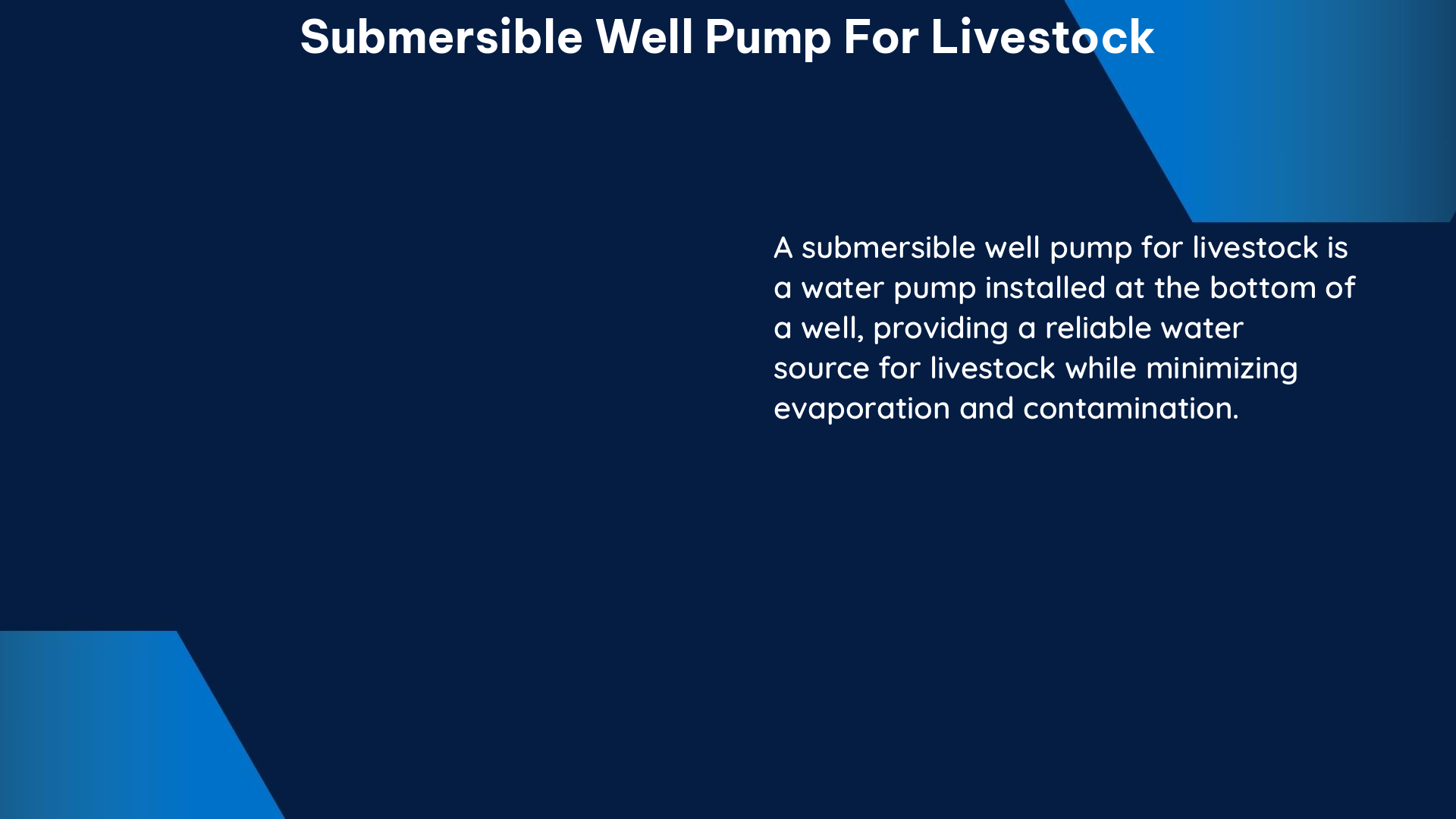A submersible well pump is a crucial component in providing a reliable water supply for livestock in remote locations. Selecting the right pump and designing the system correctly are essential to ensure efficient and uninterrupted water delivery to your animals.
Understanding Pump Flow Rate and Total Dynamic Head (TDH)
When choosing a submersible well pump for livestock, the two most important factors to consider are the pump’s flow rate and total dynamic head (TDH) requirement. The flow rate is the volume of water the pump can deliver per unit of time, typically measured in gallons per minute (GPM) or liters per second (L/s). The TDH is the sum of the vertical lift, pressure head, and friction loss in the piping system, measured in feet or meters.
To determine the appropriate pump size, you’ll need to calculate the daily water needs of your livestock operation and the TDH requirement of the system. The daily water needs can be estimated based on the number and type of animals, while the TDH requirement depends on the vertical lift, pressure head, and friction losses in the piping system.
Calculating the Design System Flow Rate

When designing a solar-powered water pump system for livestock, the design system flow rate is calculated using the following equation:
Design System Flow Rate (GPM) = Daily Water Needs (gallons/day) / Solar Insolation Value (kWh/m²/day)
For example, if the daily water requirement is 1,000 gallons/day and the solar insolation value is 2.52 kWh/m²/day, the design system flow rate would be 6.6 GPM.
Determining the Total Dynamic Head (TDH) Requirement
The TDH requirement of the pump is calculated using the following equation:
TDH (feet) = Vertical Lift (feet) + Pressure or Elevation Head (feet) + Friction Loss (feet)
The vertical lift is the distance from the pumping or dynamic water level within the well to the outlet of the well. The pressure or elevation head is the difference in elevation between the water source and the outlet. The friction loss is calculated based on the pipe size, length, and material.
Table 1 provides an example of the TDH requirement for different pipe sizes and lengths, assuming a vertical lift of 100 feet and a pressure or elevation head of 50 feet.
| Pipe Size | Pipe Length | Friction Loss | Total TDH |
|---|---|---|---|
| 1-inch | 500 feet | 50 feet | 200 feet |
| 1.25-inch | 500 feet | 25 feet | 175 feet |
| 1.5-inch | 500 feet | 15 feet | 165 feet |
Selecting the Appropriate Pump
Once you have determined the design system flow rate and TDH requirement, you can select the appropriate submersible well pump for your livestock operation. Table 2 provides an example of the pump flow rate and power requirements for different pipe sizes and TDH values.
| Pipe Size | TDH | Pump Flow Rate | Pump Power |
|---|---|---|---|
| 1-inch | 100 feet | 5 GPM | 0.5 HP |
| 1.25-inch | 175 feet | 8 GPM | 1 HP |
| 1.5-inch | 165 feet | 10 GPM | 1.5 HP |
It’s important to note that these are just examples, and the actual pump requirements may vary depending on the specific conditions of your livestock operation, such as the number and type of animals, the distance to the water source, and the terrain.
Proper Installation and Maintenance
When installing a submersible well pump for livestock, it’s crucial to ensure that the pump is correctly sized for the application and that the piping system is designed to minimize friction losses. Proper installation and regular maintenance of the pump and piping system can help ensure efficient and reliable water delivery to your livestock.
Conclusion
Selecting the right submersible well pump for your livestock operation requires careful consideration of the pump’s flow rate, TDH requirement, and power source. By using the equations and data provided in this guide, you can determine the appropriate pump size and TDH requirement based on your specific needs. Proper installation and maintenance of the pump and piping system are also essential to ensure efficient and reliable water delivery to your livestock.
References:
- Pumping Water from Remote Locations for Livestock Watering. https://extension.usu.edu/rangelands/files/Water_Remote_Locations.pdf
- Solar-Powered Water Pump Systems for Stockwater Design. https://www.nrcs.usda.gov/sites/default/files/2022-10/ND%20Technical%20Note%201%20-%20Solar-Powered%20Water%20Pump%20Systems%20for%20Stockwater%20Design_1.pdf
- Stupid Questions about submersible pumps and wells for watering cattle. https://talk.newagtalk.com/forums/thread-view.asp?DisplayType=flat&setCookie=1&tid=573721

The lambdageeks.com Core SME Team is a group of experienced subject matter experts from diverse scientific and technical fields including Physics, Chemistry, Technology,Electronics & Electrical Engineering, Automotive, Mechanical Engineering. Our team collaborates to create high-quality, well-researched articles on a wide range of science and technology topics for the lambdageeks.com website.
All Our Senior SME are having more than 7 Years of experience in the respective fields . They are either Working Industry Professionals or assocaited With different Universities. Refer Our Authors Page to get to know About our Core SMEs.